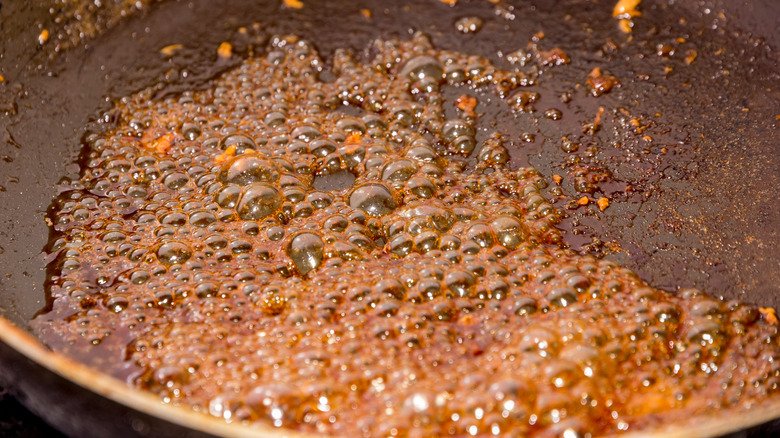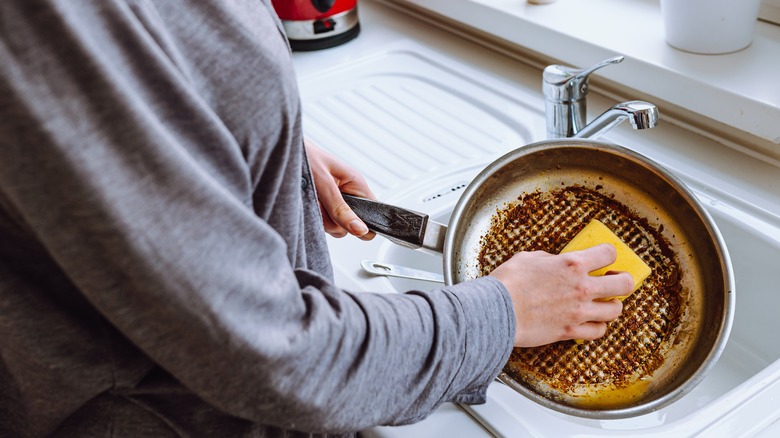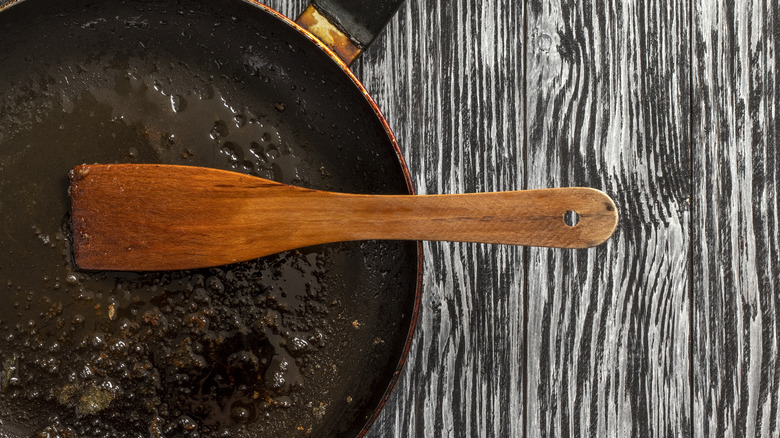The Best Way To Clean Burnt Sugar From Your Pots And Pans
It can be wonderful to transform plain granules of sugar into something entirely different. Melt sugar with water and you'll have a thick simple syrup to sweeten your favorite cocktails. Or, cook sugar until golden, whisk in butter and/or cream, and you'll have a delicious caramel sauce or a chewy candy. You could even take sugar to the brink of burning and transform it into a rich burnt sugar syrup. Actual burnt sugar, though, is a different beast. Cook sugar for too long, and it will turn into a blackened crust that sticks to your pot or pan like nothing else.
If you wind up in this situation, it will seem like no amount of scratching, scrubbing, or scraping can dislodge the mess from your pan. The real key to cleaning burnt sugar requires a different approach: it needs to be redissolved in boiling water. When you melt sugar, you turn solid crystals into a liquid. Those burnt bits on your cookware are liquid sugar that has re-crystallized, so adding boiling water to the vessel will help the stuck-on sugar to melt once more and release from your pot.
Fill your scorched pot with water and bring it to a boil on the stove, stirring the sugar to dissolve it, and then toss the liquid down the drain — that's all it takes to get rid of most cases of stubborn sugar. However, if an initial boil and rinse doesn't take care of it, you can turn to stronger solutions.
Baking soda and vinegar to the rescue
Melting burnt sugar is an easy way to get it off, especially if it's glued to non-stick cookware that can't take heavy-duty chemical cleaners or vigorous washing. However, it might take multiple rounds of boiling water to clean very stubborn sugar. To help the process along, use good ol' baking soda or vinegar.
Cover the layer of burnt sugar in your cookware with a solution of vinegar and water and simmer it on the stove for about 15 minutes. You can also use baking soda instead of vinegar and follow the same steps.
If the above method still doesn't do the trick, you can break out the hardcore cleaning products, namely Barkeepers Friend. Alternatively, you could use the boiling water method, but throw in a few scoops of baking soda, sliced lemons, or salt in the pot as well, which will add some helpful abrasive qualities. Or, use vinegar or hydrogen peroxide in place of water to loosen the burnt sugar instead.
More ways to clean burnt sugar
If your kitchen is short on ingredients, you can use an unexpected solution for burnt sugar: ketchup. This tangy condiment contains acetic acid, and when applied over burnt sugar and left to work its magic overnight, it can break the solid mass into a more pliable, easy-to-clean stain. The same can be said of Coca-Cola and cream of tartar, though the latter needs to be diluted in water and brought to a boil for it to work.
You could also look towards your laundry room for burnt sugar cleaners: Fill up the pot with water, add a tablespoon of fabric softener to it, and let it come to a boil. If it's a fabric softener sheet that you're using, take the pot off the heat before you place the sheet inside.
It's also possible to use more abrasive cleaning products, if your cookware is made from sturdier materials like stainless steel or aluminum. Burnt sugar glued to a pot that doesn't have any protective coating on it can be scrubbed with a sponge and some Bar Keepers Friend cleaning powder, a popular stainless steel cleaning product. You could even use a crumpled ball of aluminum foil or a washing pad made from stainless steel instead of a sponge, and try to tackle the sugar with soap and water. But if your cookware is made from less hardy materials, plain boiling water will be your best friend.



